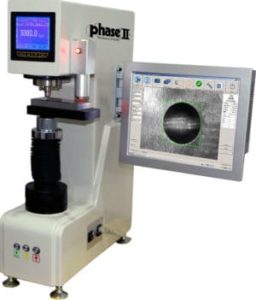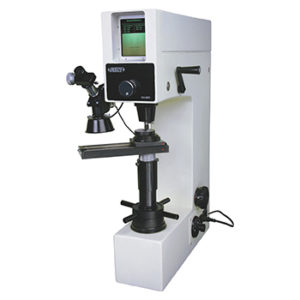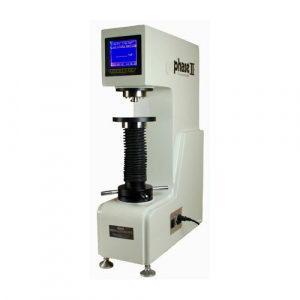In industries like engineering and manufacturing, it can be crucial to measure the properties of materials being used and produced — including the hardness of various surfaces. Products need to meet certain standards before being sold, and hardness can directly affect a material’s strength, durability, and overall suitability for certain roles.
For example, can a particular screw or bolt hold together heavy metal parts? If a piece of equipment is not hard enough, will it be less resistant to wear? Now imagine that those materials are being used to transport toxic chemicals, or form pipelines that are susceptible to corrosion. The consequences could be extremely dangerous.
For these reasons, hardness testing is vital to ensuring quality and safety.

What is a hardness tester?
It is exactly as it sounds: a hardness tester is a device used to measure the hardness of a material by measuring the indentation left when a surface is penetrated.
There are seven main types of hardness testers, including Rockwell, Vickers, Brinell, Knoop, Shore, portable and micro hardness testers; each type is suited for specific materials, applications and levels of accuracy.
What is a Brinell hardness tester and how does it work?
A Brinell hardness tester is a machine that measures hardness, particularly of metals, by creating an indentation in the material with a hardened steel ball indenter.
Following the oldest method of hardness testing developed by Dr. Johan August Brinell in Sweden in 1900, the Brinell hardness tester presses its indenter into the surface of a material, using a specified load (usually between 500 and 3000 kgf, or kilogram-force) for a period of time known as “dwell time.” Then it measures the diameter of the remaining indentation by measuring in two directions to determine the average.
Typically, Brinell hardness tests will use a steel ball indenter with a 10-millimeter diameter and a load, or force, of 3,000 kgf; less force is used for softer materials, and if necessary, the steel ball can be swapped for a tungsten carbide ball when measuring harder materials

Calculating the hardness value:
Once the diameter is measured, you use it to calculate the Brinell hardness number (BHN) using this formula: BHN = 2 P / (π D (D – (D2 – d2)1/2))
Where:
BHN = Brinell hardness number
P = the applied load (kgf)
D = diameter of the indenter (millimeters)
d = diameter of the resulting indentation (millimeters)
Benefits and applications
The benefits of the Brinell hardness tester are wide-ranging, with practical uses across industries. Professionals in engineering, design and manufacturing use this hardness test to check materials at multiple stages of their work, including after being treated, for instance, or before going to market.
Some of the benefits of the Brinell hardness tester include the following:
- Can be used for many types of materials, including metals, alloys, and even plastics
- Provides a large indentation that is well-defined, which can be helpful for testing materials with textured or coarse surfaces
- Does not damage the material being tested
- It is less sensitive
- The test covers a large area of the material, which helps to avoid inaccuracies as a result of variations across the surface (in other words, it has an averaging effect)
The practical applications of this device, too, are diverse. Some of these include:
- Choosing appropriate materials for specific uses, for example, in fields of engineering and design
- Quality control in manufacturing
- Analyzing the cause of material defects or degradation in manufacturing
- Metal processing and foundries, can be used to determine hardness of materials and ensure that quality standards are met — particularly useful when working with heat-treated metals
Contact Higher Precision for your Brinell Hardness Testers
Interested in learning more about the Brinell hardness testers available through Higher Precision, or would like to get a quote?
We’re here to answer all your questions – just contact us for more information!
FREQUENTLY ASKED QUESTIONS
- What are three types of hardness testing?
Three of the main types of hardness testers include Brinell, Rockwell and Vickers.
- Why is the Brinell hardness test used?
The Brinell hardness test is used to measure hardness of materials, particularly metals. It has a range of applications, such as ensuring quality control in manufacturing, choosing the appropriate materials in engineering and design, and analyzing material defects in manufacturing.
- What are the best Brinell hardness testers?
Many of the best quality Brinell hardness testers are available right here through Higher Precision. For example, you many want to consider the following:
BRINELL HARDNESS TESTER WITH AUTO Z-AXIS: Made by Phase II, with a maximum measuring height of 230 mm; includes hardness measurement software and automatically saves test results and images
INSIZE ISH-BRV-U BRINELL/ROCKWELL, VICKERS HARDNESS TESTER: Best for those seeking an all-in-one device for multiple purposes; comes with a range of anvils and indenters for different hardness tests
INSIZE ISHB-D200-U AUTOMATIC DIGITAL BRINELL HARDNESS TESTER: Max workpiece height of 7.87”; automatic testing with LCD touch screen
PHASE II 900-355 DIGITAL BRINELL HARDNESS TESTER: digital motorized tester with tungsten carbide ball indenter; indenter, load and other test details displayed on a large LCD screen
GLOSSARY TERMS
- Dwell time:
the period of time that a Brinell hardness tester presses its indenter into a material’s surface
- BHN:
- Brinell hardness number, which is calculated using a formula after the hardness tester makes and measures its indentation.
- Indenter:
- the part of a Brinell hardness testing device that presses into the material being tested, forming an indentation. Typically, the indenter is a hardened steel ball, but a tungsten carbide ball can be used when measuring harder materials.

